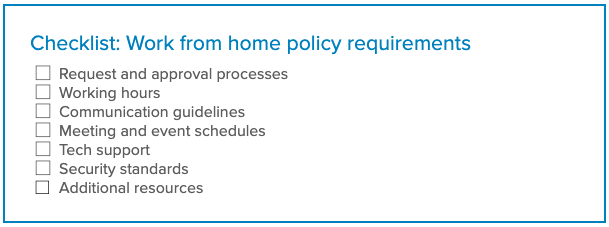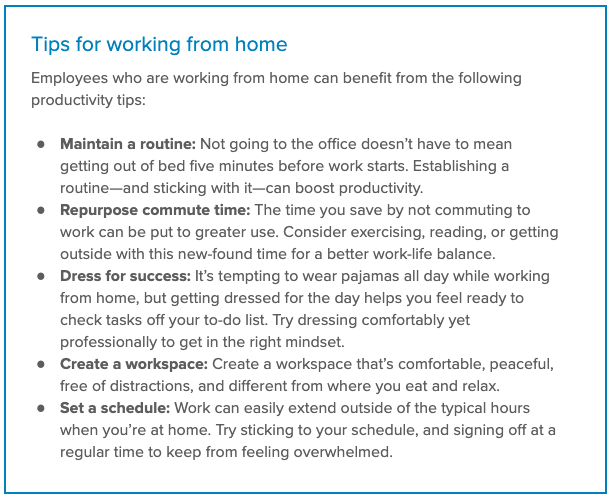Time to Make a Work from Home Policy. Where Should You Start?
A work from home (WFH) policy is a document that sets expectations for remote work. In many cases, WFH policies also outline the steps employers and employees need to follow in order to apply for and approve work from home privileges. The more information an organization provides, the more secure, effective, and productive working from home can be.
But before we can take a closer look at the type of information that should be included in a remote work policy, it’s important to understand the pros and cons that come with leading a dynamic workforce.
Benefits and challenges of working from home
A work at home program can benefit employees as well as the business. But as with any other business model, remote work also has its challenges.
Pros of working from home
- Flexibility: Today’s employees value flexibility above all else. A work from home policy gives employees more freedom to work when, where, and how they prefer.
- Engagement and productivity: Giving employees the choice to work from home shows that you trust them to get their jobs done—no matter where they’re located—and it’s been proven that employees who feel trusted are more engaged and productive.
- Reduced stress: One of the biggest benefits of working from home is that it frees up time normally spent commuting to the office. This in turn could minimize employee stress and improve overall happiness.
- Improved focus: Working in an office is great for collaboration and socialization—but some workers can be easily distracted. A WFH policy gives employees the opportunity to be in an environment that’s conducive to efficient, focused work.
- Health and attendance: Allowing employees to work from home helps to eliminate the spread of illness, which may ultimately increase attendance and minimize sick days.
Cons of working from home
- Security vulnerabilities: Working from home presents major threats, as employees might log on with personal devices. The absence of the traditional security perimeter makes it even more important for businesses to provide the tools and software that keeps their people and their information safe.
- Burnout: Not having to go into the office every day may sound great, but it can also make it difficult for employees to establish work-life boundaries. Employees who work long hours, fail to take breaks, or check email late at night may experience burnout.
- Isolation: Group environments are great for collaborating and building camaraderie. Working from home for long periods of time could affect the bonds that colleagues have with each other, and may lead to them feeling lonely and disconnected.
Work from home policy guidelines and best practices
The proliferation of smartphones, laptops, and productivity apps has made it easier to work from anywhere—but it still takes time and thoughtful consideration to create work from home rules that sets your people up for success. Here are some tips on what to include, as well as some technology considerations that will help keep your remote employees—and company data—safe.
1. Request and approval processes
Before employees can begin working from home, they need to know whether they’re eligible to do so, and how they should inform the rest of their team that they’ll be outside of the office. Do they need to fill out a form, put a request through your company’s HR platform, or speak to their manager? This part of a work from home policy should break this information into clear, simple steps.
2. Working hours
Every WFH policy should indicate when teams are expected to be working, and—more importantly—when they shouldn’t be. Establishing regular hours or periods of availability can keep people from feeling overwhelmed.
3. Communication guidelines
In an office environment, colleagues might put on headphones or close an office door to indicate that they need time to focus. But this is tricker to communicate amongst a distributed team, and productivity could be impacted if employees bombard each other with instant messages and emails. To keep disruptions to a minimum, establish standards for your internal communication channels.
4. Meeting and event schedules
Culture is just as important to maintain online as it is in an office. To help remote workers feel like part of the team, make sure to provide them with information about when and where all-hands meetings, departmental gatherings, and other events are occurring. A simple calendar (with video conferencing links) gives them an opportunity to plan whether they attend in-person or virtually—and ensures that no one is left out.
5. Tech support
We all struggle with technology sometimes, and those frustrations can be exacerbated when working remotely. Make sure your employees know when your company’s IT team is available, and how they can get in touch or submit help desk tickets.
6. Security standards
Keeping users and information secure is a vital piece of the WFH puzzle. Confirm that all employees have the necessary security or encryption software loaded onto their devices, regularly remind them of their data protection requirements, and encourage them to stay vigilant to protect against security threats.
7. Additional resources
One of the things Okta’s technology teams did in response to COVID-19 was set up a series of wiki pages for employees that outline everything from health and safety precautions to remote working tips. Centralizing these resources in your work from home policy makes it easy for employees to reference.
Technology considerations for working from home
When it comes to working from home, technology has a large role to play. Not only does it ensure everyone has the tools and software they need to do their jobs well, but it also protects company, employee, and customer information. For example, Okta’s cloud-first approach is what enabled us to swiftly and securely shift to remote work at the onset of COVID-19—and continue to do “business as usual” throughout the pandemic.
One of the most important steps companies need to take before enabling employees to work remotely is to change how they think about the security perimeter. It’s vital to protect resources—from cloud and on-prem apps to VPNs, servers, and APIs—no matter where they’re being accessed from.
To guarantee security, as well as create seamless user experiences, businesses should integrate identity and access management with other Zero Trust solutions. Combining single sign-on and multi-factor authentication (MFA) with easy-to-use tools like Okta Verify and Google Authenticator, for example, gives your workforce secure access to company data and resources.
Other access policies to consider when managing a remote team include:
- Disallowing POP/IMAP-based authentication to Office 365 to accommodate MFA.
- Creating network blocklists to prevent access from known bad networks, tor browsers, or risk geolocations.
- Rolling out email notifications to end users, altering them of suspicious activity.
- Enabling managed device checks for mobile and desktop devices to create a frictionless experience.
Setting your WFH policy up for success
Of course, in order to have a truly successful work at home program, you need to make sure it’s something employees need, want, and benefit from. Try asking for their input on policies—and make sure to effectively educate everyone on the guidelines before instating them. It’s also a great idea to regularly evaluate your work from home policy, ask for feedback, and make updates when necessary. WFH policies don’t have to be a one-and-done thing—they can evolve alongside your company.
For more insights on how to accomodate a remote work strategy and the technology that can help a distributed workforce, check out these resources:
- Adopting a Remote Work Strategy? We’re Here to Help (Blog post)
- Quick Wins + Long Term Strategies for Remote Work (Webinar)
- Remote Work Toolkit (Landing page)
- The Future of Work is Dynamic (Landing page)
- The Ultimate Guide to Dynamic Work (whitepaper)



